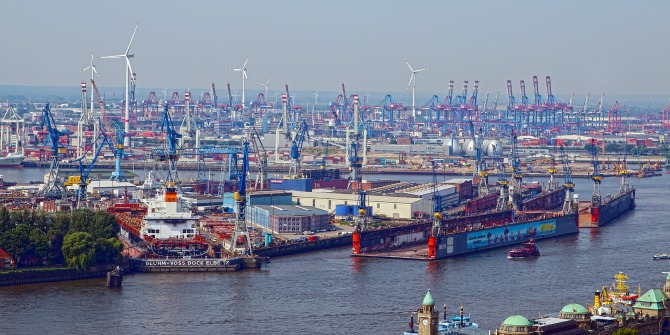 Hamburg Port, by moerschy, under a CC0 licence
Hamburg Port, by moerschy, under a CC0 licence
Over the past three decades, countries and trading blocks around the world have undertaken substantial efforts to reduce barriers to trade. In recent years, these efforts have mainly taken the form of regional free trade agreements (RTA) in which countries liberalize trade outside the multilateral framework of the World Trade Organization.
The hope behind this development is of course that RTAs will be economically beneficial for the participating nations or trade blocs. Existing economic research has shown that this is indeed the case, at least for developed economies. For example, in an influential paper Daniel Trefler (2004) showed that the Canada-US Free Trade Agreement (CUSFTA) of January 1989 led to dramatic increases in Canadian manufacturing.
While knowing with hindsight that a particular RTA has been beneficial for a country is useful, we would ideally be able to make predictions about future RTAs as well, such as the proposed US-EU Transatlantic Trade and Investment Partnership. Traditionally, so-called computable general equilibrium (CGE) trade models have been used to make such forecasts. While their use for this purpose has unquestionably been beneficial, not everybody is happy.
For example, Kehoe (2005) and Balistreri, Hillberry and Rutherford (2011) criticise the forecasting performance of CGE models and point out that they neglect the effects of trade on aggregate productivity and trade growth along the so-called extensive margin (i.e., trade increases due to more firms trading or due to firms trading more products). A newer generation of quantitative trade models based on the seminal contribution of Melitz (2003) has recently been developed to address these shortcomings. However, a thorough evaluation of the forecasting performance of these models is still at an early stage. In a recent work we use the Canada-US Free Trade Agreement to carry out such a test.
A quick look at the data suggests that CUSFTA was associated with substantial trade and productivity gains in Canada: average goods trade flows (Canadian exports plus imports to and from the US) increased by 118 per cent over the period 1988 to 1996, while the increase in labour productivity in Canadian manufacturing was 30 per cent. This compares to growth rates of only 44 per cent (trade) and 17 per cent (productivity) for the pre-liberalization period 1980-1988. As discussed, papers such as Trefler (2004) have also provided more rigorous econometric evidence that these increases can indeed be linked to the tariff cuts implemented under CUSFTA. The goal in Breinlich and Cuñat (2016) is to see to what extent different heterogeneous firm models can quantitatively replicate these increases in trade and productivity, and would thus be potentially useful for forecasting purposes.
We start with a “minimalistic” baseline model, in which Canadian tariff reductions reduce the profits of Canadian firms in their domestic market due to increased foreign competition. This crowds out the lowest-productivity firms, thus raising average industry productivity. At the same time, lower export US tariffs allow more Canadian firms to enter the export market and existing exporters can export more to the US. The same is true for US exporters, increasing overall bilateral trade flows.
While this baseline model gets the basic direction of effects right, it turns out that the predicted increase in productivity for a given change in tariffs is much too low relative to the predicted increase in trade. This forecast bias is substantial: if we match trade flow increases in our model, we obtain productivity increases of less than 2 per cent (compared to 30 per cent in the data). When we use parameter estimates obtained from the pre-CUSFTA period (1980-1988) – as we would of course have to do for forecasting purposes – the results are even worse.
This mismatch raises two possibilities. First, we might simply be too demanding of a rather simple model that abstracts from a number of factors which increase productivity and trade flows in the real world and have nothing to do with trade liberalisation (for example, on-going technical change or business cycle movements). To address this possibility, we ‘clean’ our data by removing all influences not related to tariff cuts, using techniques similar to Trefler (2004). This does help somewhat, but the basic finding that the model does not generate enough productivity gains remains.
A second possibility is that we might need to integrate additional mechanisms for productivity gains into the model. We experiment with a number of extensions but only one turns out to help us significantly in improving the model’s performance. If we allow individual firms to become more productive in response to tariff cuts, we are able to closely match the observed trade and productivity gains in Canada. Moreover, we also get good forecasts if we use parameter estimates obtained from the pre-CUSFTA period. Again, this is important because in practice we will have to work with data prior to the particular RTA whose effects we want to forecast.
Overall, our results suggest that if we want to use the current generation of heterogeneous firm models for the purpose of forecasting the effects of RTAs, we need to allow for sources of within-firm productivity increases. Otherwise, our models will tend to dramatically underestimate the effect of free trade on productivity and might consequently lead us to abandon promising free trade initiatives. Indeed, at least for CUSFTA, there is independent evidence which suggests that within-firm productivity effects were actually very important (see Lileeva and Trefler 2011). Of course, this does not mean that within-firm productivity increases will be important in all contexts, and more standard heterogeneous firm models might do better in such cases. But there is also evidence that within-firm effects were important in other liberalization episodes (see, for example, Bustos 2011 for evidence of the impact of MERCOSUR on Argentinian firms).
♣♣♣
Notes:
- This post appeared originall at VoxEu and is based on the author’s paper “Tariffs, Trade and Productivity: A Quantitative Evaluation of Heterogeneous Firm Models,” co-authored with Alejandro Cuñat, Economic Journal, Sept. 2016, Vol. 126, Issue 595.
- The post gives the views of its author, not the position of LSE Business Review or the London School of Economics.
- Before commenting, please read our Comment Policy.
 Holger Breinlich is a Professor of International Economics at the University of Nottingham. He is also a Research Fellow at the Centre for Economic Policy Research (CEPR), a Research Associate at the Centre for Economic Performance (CEP) and an internal Research Fellow at the Centre for Research on Globalisation and Economic Policy (GEP). His research interests are in the fields of international trade, economic geography and applied econometrics. Holger Breinlich received his PhD from the London School of Economics in 2006.
Holger Breinlich is a Professor of International Economics at the University of Nottingham. He is also a Research Fellow at the Centre for Economic Policy Research (CEPR), a Research Associate at the Centre for Economic Performance (CEP) and an internal Research Fellow at the Centre for Research on Globalisation and Economic Policy (GEP). His research interests are in the fields of international trade, economic geography and applied econometrics. Holger Breinlich received his PhD from the London School of Economics in 2006.





